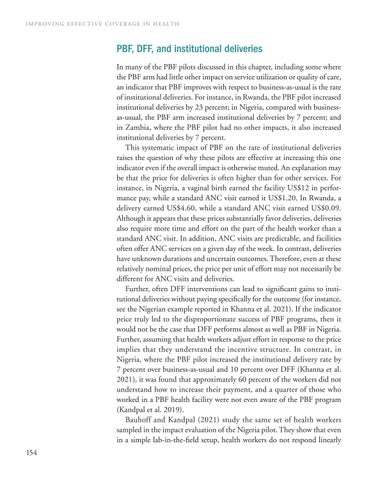IMPROVING EFFECTIVE COVERAGE IN HEALTH
PBF, DFF, and institutional deliveries In many of the PBF pilots discussed in this chapter, including some where the PBF arm had little other impact on service utilization or quality of care, an indicator that PBF improves with respect to business-as-usual is the rate of institutional deliveries. For instance, in Rwanda, the PBF pilot increased institutional deliveries by 23 percent; in Nigeria, compared with businessas-usual, the PBF arm increased institutional deliveries by 7 percent; and in Zambia, where the PBF pilot had no other impacts, it also increased institutional deliveries by 7 percent. This systematic impact of PBF on the rate of institutional deliveries raises the question of why these pilots are effective at increasing this one indicator even if the overall impact is otherwise muted. An explanation may be that the price for deliveries is often higher than for other services. For instance, in Nigeria, a vaginal birth earned the facility US$12 in performance pay, while a standard ANC visit earned it US$1.20. In Rwanda, a delivery earned US$4.60, while a standard ANC visit earned US$0.09. Although it appears that these prices substantially favor deliveries, deliveries also require more time and effort on the part of the health worker than a standard ANC visit. In addition, ANC visits are predictable, and facilities often offer ANC services on a given day of the week. In contrast, deliveries have unknown durations and uncertain outcomes. Therefore, even at these relatively nominal prices, the price per unit of effort may not necessarily be different for ANC visits and deliveries. Further, often DFF interventions can lead to significant gains to institutional deliveries without paying specifically for the outcome (for instance, see the Nigerian example reported in Khanna et al. 2021). If the indicator price truly led to the disproportionate success of PBF programs, then it would not be the case that DFF performs almost as well as PBF in Nigeria. Further, assuming that health workers adjust effort in response to the price implies that they understand the incentive structure. In contrast, in Nigeria, where the PBF pilot increased the institutional delivery rate by 7 percent over business-as-usual and 10 percent over DFF (Khanna et al. 2021), it was found that approximately 60 percent of the workers did not understand how to increase their payment, and a quarter of those who worked in a PBF health facility were not even aware of the PBF program (Kandpal et al. 2019). Bauhoff and Kandpal (2021) study the same set of health workers sampled in the impact evaluation of the Nigeria pilot. They show that even in a simple lab-in-the-field setup, health workers do not respond linearly 154

